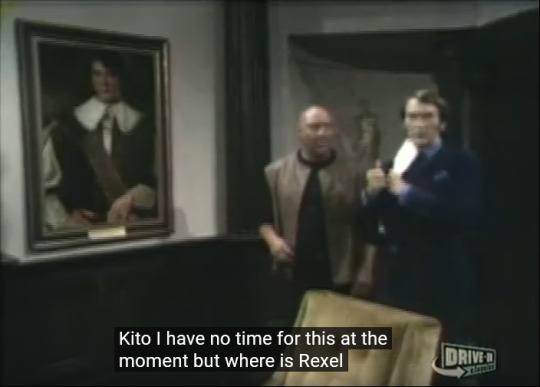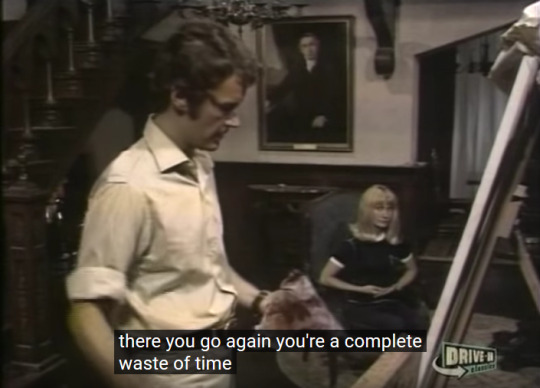#bruce gray was a good actor but tim stanton is zzzzzzzzz
Explore tagged Tumblr posts
Text
Ian Martin’s Strange Paradise, Part II: The Top 5 Worst Things

Last week, I listed my top five favorite things about the first 44 episodes of Strange Paradise, when Ian Martin was headwriter and when the show had a very different feel to it than in the final four weeks of the Maljardin arc. But no creative work is perfect, and, despite my fondness for this show, I’d be lying if I said I didn’t think that the writing for early Maljardin had several glaring flaws. Unlike Danny Horn, I don’t think that Ron Sproat was a better writer than Martin (actually, I consider Sproat the worst writer on SP), but that doesn’t mean that I don’t also feel that his writing needed some improvement. Note that this entry is specifically about the writing during this period, so things outside his creative control (e.g. the Conjure Man’s questionable casting) will be excluded from the list.
That said, here are my top five least favorite things about the writing in the first nine weeks of Strange Paradise:

5. Cheesy dialogue
More specifically, (1) bad jokes and (2) slang that was already outdated when these episodes originally aired in 1969. This one is #5 because, while these lines are cheesy, I can’t hate them because most of them make me laugh. Even my personal least favorite of Jacques’ jokes, the “pose” line from Episode 18, is kind of funny in an ironic, anti-humor sort of way, like the dad jokes that have become fashionable in recent years. While there are some jokes in this show that I find genuinely funny--Elizabeth’s Song of Solomon joke, for instance, or “the lady doth detest too much”--most others are the epitome of cornball. Sometimes you hear both in the same episode: Episode 21 is loaded with Devil jokes/puns that would be unforgivably corny if Colin Fox didn’t possess enough charisma to sell them, and yet the same episode also features a genuinely hilarious double entendre. The good jokes sneak up on you, sometimes amidst a hurricane of bad ones.
As for the slang, some comments that I’ve read mention that it was largely out of date even in the late sixties. My good friend Steve (with whom I often discuss SP) has told me that “you might not be aware of how campy that slang sounded in 1969 since you obviously did not live through the Sixties--this happened with a lot of TV shows during that period, the most egregious examples being the various ‘evil druggie Hippie’ episodes of DRAGNET.” Apparently Martin became infamous for using outdated slang later on when he wrote for CBS Radio Mystery Theater, putting lines like “I dig a man who’s far-out!” and “I think bein’ around here’s gonna be kicks!” in the mouths of some of his younger characters. Even if he had used up-to-date slang, it most likely would have still aged poorly (as slang typically does), especially for generations born after phrases like “the most” and “making the ___ scene” fell out of use.

4. Slow pace and excessive repetition
This one is also low on the list, because slow pace and repetition weren’t flaws when the show originally aired, but instead have aged poorly because of advances in technology that made them unnecessary. Before the advent of the programmable VCR, you had to be able to catch the program you wanted to watch on time or have someone you knew catch it on time and record it--which, in 1969, would have meant an audio-only tape recording. This meant that only the most fortunate and/or most loyal viewers would have been able to watch Strange Paradise every day, making it necessary to recap all the major events in subsequent episodes for those who missed out. This is also likely the reason why early SP (like most soaps of the time) has a relatively slow pace: if too much happens in one episode, you have to recap more and the people who missed the big episode are more disappointed.
Nowadays, with DVRs, video streaming, and DVD sets--not to mention certain legally-questionable means--it’s nearly impossible to miss an episode of your favorite show (with few exceptions), making extensive recap largely obsolete. Screenwriters can cram as many plot points as they want into one episode and no longer have to write five episodes of the other characters reacting to the news if they don’t want to.
Even so, just because the constant recap served a function at the time doesn’t mean I have to like it. It gets annoying hearing the same plot points reiterated episode after episode. Like I said while reviewing Episode 21, “if someone were to remake this show for Netflix or another streaming service, they could safely ignore about 75 percent of the original scripts and condense the remaining 25 percent quite a bit without omitting anything important.”
And don’t even get me started on the lampshading of absent cast members, like in Episode 9 when Jean Paul and Quito wasted two minutes searching for Raxl just to slow the plot down. It’s nothing compared to Ron Sproat’s “we must search for Quito” filler episode in Desmond Hall (Episode 78), but still, those scenes were pointless.

3. Extreme artistic license with certain historical/cultural details
Although Ian Martin did a surprising amount of research on certain subjects for Strange Paradise, there are some subjects where he either didn’t do enough research, or (more likely) made extensive use of artistic license. The first one is his portrayal of Jacques’ wife Huaco as an Inca princess despite their marriage occurring over a century after the fall of the Inca Empire. I discussed this all the way back in Part II of my review of the pilot, where I invented the theory of Jacques traveling back in time to marry her, but other possible explanations include Huaco being a 17th-century descendant of Inca royalty (as the Quechua people are still alive today), extreme artistic license, and/or critical research failure. I don’t know if we would have eventually gotten a good explanation if Martin had continued writing the series, but we would need a damn good one for the approximate equivalent of having a 21st-century character marry the Russian Grand Duchess Anastasia. I’m willing to suspend my disbelief and accept it considering that this is a fantasy series, but it still creates a lot of plot holes that need to be filled.[1]
Another example of artistic license about which I feel more ambivalent is the conflation of voodoo with the Aztec-inspired indigenous religion of Maljardin, which I’ve discussed before both in my Episode 23 review and Part I of this post series. I’m not sure if this is genius--religious syncretism is a real phenomenon throughout the Caribbean and Latin America, and some people today do syncretize the vodou Serpent God with Quetzalcoatl--or just an instance of Martin playing fast and loose with facts. I would like to think it’s the former, but it could just as easily be the latter (hence why I referenced it on both lists--I have mixed feelings about it).

2. Annoying inconsistencies
Does Raxl know that Jean Paul is possessed by Jacques Eloi des Mondes? Does Vangie? Why does Jacques’ portrait disappear in some episodes after he possesses Jean Paul, but not in others? All three of these things vary from episode to episode, and change annoyingly often as the plot demands. Steve and I have also discussed this subject in the past, and he believes that Martin used this device to make the story easier to follow; if that’s the case, it appears that he used Raxl and Vangie as audience surrogates, especially for new viewers or people who didn’t tune in every day. But surely there were other ways to do that without creating continuity errors? It may have served a function, but that doesn’t make it good writing. What Martin is essentially doing is filling and reopening the same plothole, episode after episode.
Regarding the portrait, I don’t know how much to blame Martin’s scripts for this inconsistency and how much to blame the directors, as I don’t have access to any SP scripts beyond the pilot script and the Vignettes. However, I’m going to assume that he’s at least partially to blame, because at least the pilot script mentions the disappearing portrait (which literally disappears in all three of the Paperback Library novels), Also, while none of the characters ever mention the portrait vanishing (unlike in the tie-in novels), some of his episodes have characters looking at it while Jacques is controlling Jean Paul and commenting on the uncanny resemblance. See also the diegesis tag for more discussion and analysis of the disappearing portrait.

1. Tim’s subplot
It should surprise none of my regular readers that Tim’s subplot is my #1 least favorite thing about the first nine weeks of Maljardin. I’ve already written an entire post about why I dislike this subplot, so I’ll keep my discussion of it here brief. Jean Paul saves the life of artist Tim Stanton when he hires him to paint Erica’s portrait, but then does nothing to make the commission easy for him--which is not a bad set-up for a plot in and of itself, but the execution is terrible. Tim chooses to use Holly as his model despite her barely resembling Erica, and Martin mostly uses their subsequent interactions to drive the old, tired, clichéd plot where two people who bicker and hate each other at first eventually fall in love (or at least he appears to be setting that up[2]). The payoff for the Holly portrait subplot finally occurs in Episode 33, but it’s underwhelming (not to mention barely recapped) and the already bland Tim quickly becomes a background character. In short, his subplot is a boring waste of time and should have either had more payoff or--preferably--been scrapped altogether.
That concludes my list of the worst things about Ian Martin’s Strange Paradise. Stay tuned for my review of Episode 45 within the next two weeks.
{<- Previous: The Top 5 Best Things }
Note
[1] Interestingly, there is a possible (if unlikely) historical explanation for Huaco’s sister Rahua having “skin as white as goat’s milk” and “hair like ripened wheat.” An early Spanish account of the Chachapoya people (aka Cloud People) of the Northern Andes describe them as “the whitest and most handsome of all the people that I have seen, and their wives were so beautiful that because of their gentleness, many of them deserved to be the Incas’ wives and to also be taken to the Sun Temple.” Assuming the Spanish account isn’t made up, this proves that reality is sometimes unrealistic.
[2] Thankfully, given the soap opera genre, it’s unlikely that Tim and Holly would have stayed together forever, even if they had eventually fallen in love during their painting-and-bickering sessions. Even so, that doesn’t make it a good subplot.
#strange paradise#ian martin#maljardin arc#review#analysis#arc review#list#bruce gray was a good actor but tim stanton is zzzzzzzzz#even jean paul agrees ;)
2 notes
·
View notes